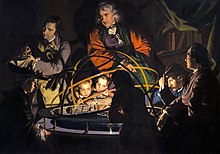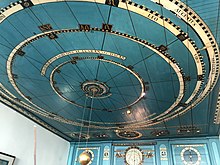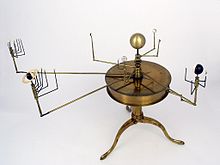Orrery

Anorreryis a mechanicalmodel of the Solar Systemthat illustrates or predicts the relative positions and motions of theplanetsandmoons,usually according to theheliocentric model.It may also represent the relative sizes of these bodies; however, since accurate scaling is often not practical due to the actual large ratio differences, a scaled-down approximation may be used instead.The Greekshad workingplanetaria,but the first modern example was produced c. 1712 by John Rowley.[1]He named it orrery[2]forCharles Boyle, 4th Earl of Orrery(inCounty Cork,Ireland). The plaque on it reads "Orrery invented by Graham 1700 improved by Rowley and presented by him to John [sic] Earl of Orrery after whom it was named by at the suggestion of Richard Steele."
They are typically driven by aclockworkmechanism with a globe representing theSunat the centre, and with a planet at the end of each of the arms.
History
[edit]Ancient
[edit]

TheAntikythera mechanism,discovered in 1901 in a wreck off the Greek island ofAntikytherain the Mediterranean Sea, exhibited thediurnal motionsof theSun,Moon,and the fiveplanetsknown to theancient Greeks.It has been dated between 205 to 87 BC.[3][4][5]The mechanism is considered one of the first orreries.[6]It wasgeocentricand used as a mechanical calculator to calculate astronomical positions.
Cicero,the Roman philosopher and politician writing in the first century BC, has references describing planetary mechanical models. According to him, the Greek polymathsThales[7]andPosidonius[8]both constructed a device modeling celestial motion.
Early Modern
[edit]
In 1348,Giovanni Dondibuilt the first known clock driven mechanism of the system. It displays theecliptic positionof the Moon, Sun,Mercury,Venus,Mars,JupiterandSaturnaccording to the complicatedgeocentricPtolemaic planetary theories.[9][10]The clock itself is lost, but Dondi left a complete description of its astronomicgear trains.
As late as 1650, P. Schirleus built a geocentricplanetariumwith the Sun as a planet, and with Mercury and Venus revolving around the Sun as itsmoons.[11]
At the court ofWilliam IV, Landgrave of Hesse-Kasseltwo complicated astronomic clocks were built in 1561 and 1563–1568. These use four sides to show the ecliptical positions of the Sun, Mercury, Venus, Mars, Jupiter, Saturn, the Moon, Sun and Dragon (Nodes of the Moon) according toPtolemy,a calendar, the sunrise and sunset, and an automatedcelestial spherewith an animated Sun symbol which, for the first time on a celestial globe, shows the real position of the Sun, including theequation of time.[12][13]The clocks are now on display inKasselat the Astronomisch-Physikalisches Kabinett and inDresdenat theMathematisch-Physikalischer Salon.
InDe revolutionibus orbium coelestium,published in Nuremberg in 1543,Nicolaus Copernicuschallenged the Western teaching of a geocentric universe in which the Sun revolved daily around theEarth.He observed that some Greek philosophers such asAristarchus of Samoshad proposed a heliocentric universe. This simplified the apparentepicyclicmotions of the planets, making it feasible to represent the planets' paths as simple circles. This could be modeled by the use of gears.Tycho Brahe's improved instruments made precise observations of the skies (1576–1601), and from theseJohannes Kepler(1621) deduced that planets orbited the Sun inellipses.In 1687Isaac Newtonexplained the cause of elliptic motion in histheory of gravitation.[14]
Modern
[edit]


There is an orrery built by clock makersGeorge GrahamandThomas Tompiondatedc. 1710in theHistory of Science Museum, Oxford.[15]Graham gave the first model, or its design, to the celebrated instrument maker John Rowley of London to make a copy forPrince Eugene of Savoy.Rowley was commissioned to make another copy for his patronCharles Boyle, 4th Earl of Orrery,from which the device took its name in English.[16][17]This model was presented to Charles' son John, later the5th Earl of Cork and 5th Earl of Orrery.Independently,Christiaan Huygenspublished in 1703 details of a heliocentric planetary machine which he had built while living in Paris between 1665 and 1681. He calculated the gear trains needed to represent a year of 365.242 days, and used that to produce the cycles of the principal planets.[11]
Joseph Wright's paintingA Philosopher giving a Lecture on the Orrery(c. 1766), which hangs in theDerby Museum and Art Gallery,depicts a group listening to a lecture by anatural philosopher.The Sun in a brass orrery provides the only light in the room. The orrery depicted in the painting has rings, which give it an appearance similar to that of anarmillary sphere.The demonstration was thereby able to depicteclipses.[18]
To put this in chronological context, in 1762John Harrison'smarine chronometerfirst enabled accurate measurement oflongitude.In 1766, astronomerJohann Daniel Titiusfirst demonstrated that the mean distance of each planet from the Sun could be represented by the following progression:
That is, 0.4, 0.7, 1.0, 1.6, 2.8,... The numbers refer toastronomical units,the mean distance between Sun and Earth, which is 1.496 × 108km (93 × 106miles). The Derby Orrery does not show mean distance, but demonstrated the relative planetary movements.
TheEisinga Planetariumwas built from 1774 to 1781 byEise Eisingain his home inFraneker,in the Netherlands. It displays the planets across the width of a room's ceiling, and has been in operation almost continually since it was created.[19]This orrery is a planetarium in both senses of the word: a complex machine showing planetary orbits, and a theatre for depicting the planets' movement. Eisinga house was bought by the Dutch Royal family who gave him a pension.

In 1764, Benjamin Martin devised a new type of planetary model, in which the planets were carried on brass arms leading from a series of concentric or coaxial tubes. With this construction it was difficult to make the planets revolve, and to get the moons to turn around the planets. Martin suggested that the conventional orrery should consist of three parts: the planetarium where the planets revolved around the Sun, thetellurion(alsotellurianortellurium) which showed the inclined axis of the Earth and how it revolved around the Sun, and the lunarium which showed the eccentric rotations of the Moon around the Earth. In one orrery, these three motions could be mounted on a common table, separately using the central spindle as a prime mover.[6]
Workings
[edit]All orreries areplanetariums.The termorreryhas only existed since 1714. Agrand orreryis one that includes theouter planetsknown at the time of its construction. The word planetarium has shifted meaning, and now usually refers to hemispherical theatres in which images of the night sky are projected onto an overhead surface. Orreries can range widely in size from hand-held to room-sized. An orrery is used to demonstrate the motion of the planets, while a mechanical device used to predict eclipses andtransitsis called anastrarium.
An orrery should properly include the Sun, the Earth and the Moon (plus optionally other planets). A model that only includes the Earth, the Moon, and the Sun is called atellurionor tellurium, and one which only includes the Earth and the Moon is alunarium.Ajovilabeis a model of Jupiter and its moons.[20]
| Planet | Average distance from Sun (AU) | Diameter (in Earth diameters) | Mass (inEarth masses) | Density (g/cm3) | No. of moons | Orbital period (years) | Inclination to ecliptic (degrees) | Axial tilt (degrees) | Rotational period (sidereal) |
|---|---|---|---|---|---|---|---|---|---|
| Mercury | 0.39 | 0.38 | 0.05 | 5.5 | 0 | 0.24 | 7.0° | 0° | 59 days |
| Venus | 0.72 | 0.95 | 0.82 | 5.3 | 0 | 0.62 | 3.4° | 177° | -243 days |
| Earth | 1.00 | 1.00 | 1.00 | 5.5 | 1 | 1.00 | 0° | 23° | 23.9 hours |
| Mars | 1.52 | 0.53 | 0.11 | 3.9 | 2 | 1.88 | 1.9° | 25° | 24.5 hours |
| Jupiter | 5.20 | 11.21 | 317.9 | 1.3 | 95 | 11.9 | 1.3° | 3° | 10 hours |
| Saturn | 9.54 | 9.45 | 95.2 | 0.7 | 146 | 29.5 | 2.5° | 27° | 11 hours |
| Uranus | 19.2 | 4.01 | 14.5 | 1.3 | 28 | 84 | 0.8° | 98° | -17 hours |
| Neptune | 30.1 | 3.88 | 17.1 | 1.6 | 16 | 165 | 1.8° | 28° | 16 hours |
A planetarium will show theorbital periodof each planet and therotation rate,as shown in the table above. A tellurion will show theEarth with the Moonrevolving around the Sun. It will use the angle ofinclination of the equatorfrom the table above to show how it rotates around its own axis. It will show the Earth's Moon, rotating around the Earth.[21]A lunarium is designed to show thecomplex motions of the Moonas it revolves around the Earth.
Orreries are usually not built toscale.Human orreries, where humans move about as the planets, have also been constructed, but most are temporary. There is a permanent human orrery atArmagh ObservatoryinNorthern Ireland,which has the six ancient planets,Ceres,and cometsHalleyandEncke.Uranus and beyond are also shown, but in a fairly limited way.[22]Another is at Sky's the Limit Observatory and Nature Center inTwentynine Palms, California;it is a true to scale (20 billion to one), true to position (accurate to within four days) human orrery. The first four planets are relatively close to one another, but the next four require a certain amount of hiking in order to visit them.[23]A census of all permanent human orreries has been initiated by the French group F-HOU with a new effort to study their impact for education in schools.[24]A map of known human orreries is available.[25]
A normal mechanical clock could be used to produce an extremely simple orrery to demonstrate the principle, with the Sun in the centre, Earth on the minute hand and Jupiter on the hour hand; Earth would make 12 revolutions around the Sun for every 1 revolution of Jupiter. As Jupiter's actual year is 11.86 Earth years long, the model would lose accuracy rapidly.
Projection
[edit]Manyplanetariumshave aprojection orrery,which projects onto the dome of the planetarium a Sun with either dots or small images of the planets. These usually are limited to the planets from Mercury to Saturn, although some include Uranus. The light sources for the planets are projected onto mirrors which are geared to a motor which drives the images on the dome. Typically the Earth will circle the Sun in one minute, while the other planets will complete an orbit in time periods proportional to their actual motion. Thus Venus, which takes 224.7 days to orbit the Sun, will take 37 seconds to complete an orbit on an orrery, and Jupiter will take 11 minutes, 52 seconds.
Some planetariums have taken advantage of this to use orreries to simulate planets and their moons. Thus Mercury orbits the Sun in 0.24 of an Earth year, whilePhobosandDeimosorbit Mars in a similar 4:1 time ratio. Planetarium operators wishing to show this have placed a red cap on the Sun (to make it resemble Mars) and turned off all the planets but Mercury and Earth. Similar approximations can be used to showPlutoand its five moons.
Notable examples
[edit]
ShoemakerJohn FultonofFenwick, Ayrshire,built three between 1823 and 1833. The last is in Glasgow'sKelvingrove Art Gallery and Museum.
The Eisinga Planetarium built by awool cardernamed Eise Eisinga in his own living room, in the small city ofFranekerinFriesland,is in fact an orrery. It was constructed between 1774 and 1781. The base of the model faces down from the ceiling of the room, with most of the mechanical works in the space above the ceiling. It is driven by a pendulum clock, which has 9 weights or ponds. The planets move around the model in real time.[26]
An innovative concept is to have people play the role of the moving planets and other Solar System objects. Such a model, called a human orrery, has been laid out at the Armagh Observatory.[22]
In popular culture
[edit]- The construction systemMeccanois a popular tool for constructing highly accurate orreries. Model 391, the first Meccano Orrery, was described in the June 1918 Meccano Manual.[27][28]
- InDune Messiah,the 1969sequeltoDune,there is a description of a desktop orrery representing the two moons of the fictional planetArrakisand its sun.
- In the backstory of the 1982 filmThe Dark Crystal,the UrSkek TekTih made a giant automatic orrery, with the help of his fellow UrSkek ShodYod, for Aughra, in the mountaintop observatory where she lives.
- In the1999 version of Tarzan,thetitle characterstudies an orrery with planets on it.
- In the 2000 science fiction filmPitch Black,an orrery was used to demonstrate a pendingeclipseof the planet.
- In the 2020 historical novelA Room Made of LeavesbyKate Grenville,a makeshift orrery is made from scraps found in the early colony ofNew South Walesby its first astronomer,William Dawes.
See also
[edit]References
[edit]- ^"Orrery made by John Rowley for the Earl of Orrery | Science Museum Group Collection".
- ^"Oxford English Dictionary".oed.Retrieved11 July2024.
- ^de Solla, Price, Derek(1974). "Gears from the Greeks. The Antikythera Mechanism: A Calendar Computer from ca. 80 BC".Transactions of the American Philosophical Society.64(7): 1–70 (page 19).doi:10.2307/1006146.JSTOR1006146.S2CID222364275.
{{cite journal}}:CS1 maint: multiple names: authors list (link) - ^Carman, Christián C.; Evans, James (15 November 2014). "On the epoch of the Antikythera mechanism and its eclipse predictor".Archive for History of Exact Sciences.68(6): 693–774.doi:10.1007/s00407-014-0145-5.hdl:11336/98820.S2CID120548493.
- ^Markoff, John (24 November 2014)."On the Trail of an Ancient Mystery – Solving the Riddles of an Early Astronomical Calculator".The New York Times.Retrieved25 November2014.
- ^abCalvert, H. R. (1967).Astronomy: Globes Orreries and other Models.London: H.M.S.O.ASINB001A9C9SQ.
- ^Cicero, Marcus.de Re Publica I(in Latin).
dicebat enim Gallus sphaerae illius alterius solidae atque plenae vetus esse inventum, et eam a Thalete Milesio primum esse tornatam, post autem ab Eudoxo Cnidio, discipulo ut ferebat Platonis, eandem illam astris quae caelo inhaererent esse descriptam;
- ^Cicero, Marcus.De Natura Deorum[Treatises On The Nature Of The Gods]. Translated by Yonge, Charles. p. 253.
But if that sphere which was lately made by our friend Posidonius, the regular revolutions of which show the course of the sun, moon, and five wandering stars, as it is every day and night performed, were carried into Scythia or Britain, who, in those barbarous countries, would doubt that that sphere had been made so perfect by the exertion of reason?
- ^King, Henry C.; Millburn, John R. (1978).Geared to the stars: the evolution of planetariums, orreries, and astronomical clocks.Toronto:University of Toronto Press.pp.28–41.ISBN0-8020-2312-6.
- ^Lloyd, H. Alan (1958).Some Outstanding Clocks Over Seven Hundred Years.London: Leonard Hill Books Limited. pp. 9–24.
- ^abBrewster, David (1830)."Planetary Machines".The Edinburgh Encyclopedia.Vol. 16. Edinburgh: William Blackwood et al. p. 624.
- ^Lloyd (1958), pp. 46–57.
- ^Poulle, Emmanuel;Sändig, Helmut; Schardin, Joachim; Hasselmeyer, Lothar (2008).Die Planetenlaufuhr: ein Meisterwerk der Astronomie und Technik der Renaissance geschaffen von Eberhard Baldewein 1563 - 1568(1ª ed.). Stuttgart: Dt. Gesellschaft für Chronometrie.ISBN978-3-89870-548-6.
- ^Ronan, Colin (1992) [First published 1981].The Practical Astronomer.London: Bloomsbury Books. pp. 108–112.ISBN1-85471-047-8.
- ^"Orrery, by Thomas Tompion and George Graham, London, c. 1710".Retrieved29 June2021.
- ^"orrery".Oxford English Dictionary(Online ed.).Oxford University Press.(Subscription orparticipating institution membershiprequired.)
- ^Ley, Willy (February 1965)."Forerunners of the Planetarium".For Your Information.Galaxy Science Fiction.pp. 87–98.
- ^"Revolutionary Players".Search.revolutionaryplayers.org.uk. Archived fromthe originalon 2011-07-24.Retrieved2010-02-09.
- ^"Welcome - Planetarium Friesland".planetarium-friesland.nl.
- ^Pentz, M.J. (1971).The Earth, Its Shape, Internal Structure and Composition.Vol. OU_S100_22. Bletchley:Open University Press.ISBN978-0-335-02034-8.
- ^"Adler Planetarium:Research Collections".1300 South Lake Shore Drive • Chicago IL 60605: Adler Planetarium. 2010. Archived fromthe originalon 27 January 2012.Retrieved22 June2011.
{{cite web}}:CS1 maint: location (link) - ^ab"Human Orrery".Armagh Observatory and Planetarium.Archivedfrom the original on 2023-04-02.
- ^"Orrery".Sky's The Limit Observatory & Nature Center.
- ^"The Human Orrery".planetaire.over-blog.
- ^"Emmanuel Rollinde's" Planetaires Humains - Human Orreries "List".Emmanuel Rollinde's "Planetaires Humains - Human Orreries" List.
- ^Sixma, H (November 1934)."The Franeker Planetarium".Popular Astronomy.XLII(9). SAO/NASA ADS: 489–495.Bibcode:1934PA.....42..489S.Retrieved2011-06-22.
- ^"Analysis of Meccano Manuals - Manual Models Listings".meccanoindex.co.uk.
- ^Whiting, Michael (2007)."Orrery Developments:The Use of Meccano in Constructing Planetaria"(PDF).Bulletin of the Scientific Instrument Society(94): 26–30.CiteSeerX10.1.1.694.9199.Archived fromthe original(PDF)on 21 December 2014.Retrieved2017-05-03.
Further reading
[edit]- Buick, Tony (2020).Orreries, Clocks, and London Society: The Evolution of Astronomical Instruments and Their Makers, 2nd Ed.Cham, Switzerland: Springer.ISBN978-3-030-61776-9.


